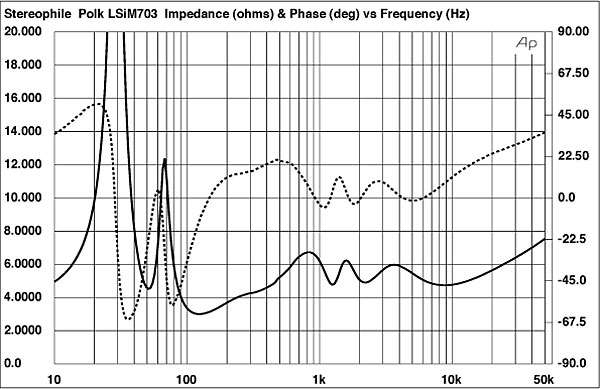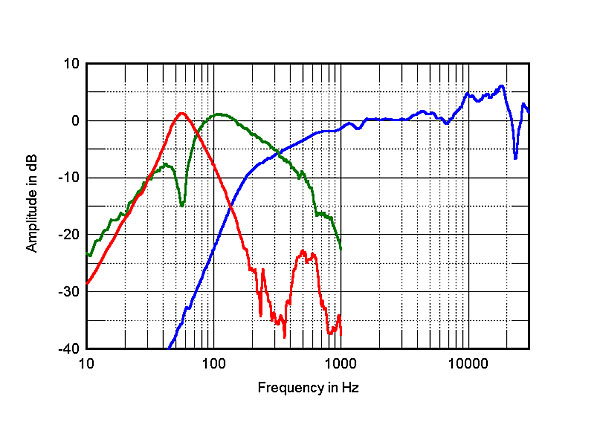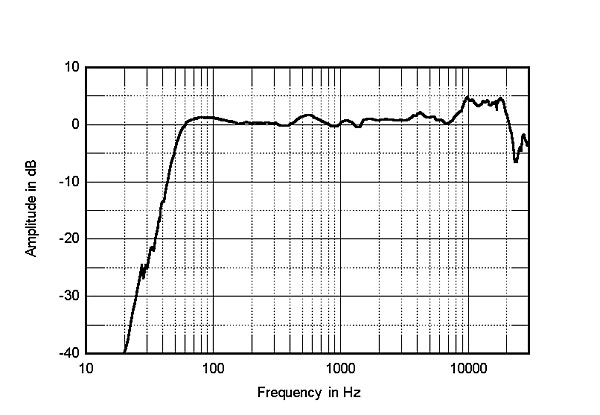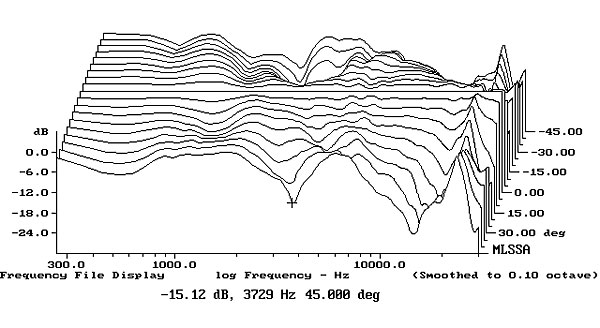| Columns Retired Columns & Blogs |
Polk LSiM703 loudspeaker Measurements
Sidebar 3: Measurements
I used DRA Labs' MLSSA system and a calibrated DPA 4006 microphone to measure the Polk LSiM703's frequency response in the farfield, and an Earthworks QTC-40 for the nearfield and spatially averaged room responses. With its ¼" capsule, the Earthworks mike is small enough to not significantly affect the tuning of the port when used to take a nearfield measurement.
I estimated the LSiM703's B-weighted voltage sensitivity as 87dB/2.83V/m, 1dB lower than the specification. The electrical impedance (fig.1, solid trace) remained between 4 and 7 ohms over most of the audioband, but dropped to 3 ohms at 125Hz. There is also an awkward combination of 4 ohms and –47° phase angle at 90Hz, a frequency where music can have considerable energy. Polk specifies the LSiM703 as being "compatible with 8 ohm outputs," but I suggest that a good 4 ohm–rated amplifier or receiver would work best with this speaker.

Fig.1 Polk LSiM703, electrical impedance (solid) and phase (dashed) (2 ohms/vertical div.).
The impedance traces are free from the small discontinuities that would suggest the presence of enclosure panel resonances. Although Bob Reina noted that the knuckle-rap test "indicated an enclosure fairly free of resonances for a speaker of its size and price," I found two strong resonant modes: one on the side panel, at 363Hz (fig.2); and one at 465Hz, present on all surfaces. Bob didn't comment on any coloration that might be laid at the feet of these modes; as always, it's possible they measure worse than they sound.

Fig.2 Polk LSiM703, cumulative spectral-decay plot calculated from output of accelerometer fastened to center of side panel (MLS driving voltage to speaker, 7.55V; measurement bandwidth, 2kHz).
Fig.3 shows the individual responses of the LSiM703's tweeter and midrange units (blue trace), the woofer (green), and the port (red), scaled in the ratio of their radiating diameters and all measured without the grille. The impedance plot suggests that the big, flared port on the cabinet's rear is tuned to 55Hz, and the woofer's output does have the expected notch centered on that frequency. The port's output reaches its maximum level at the same frequency in textbook manner, and while there are some peaks in its midrange output, these are low in level and will be ameliorated by the fact that the port both faces away from the listener and is obscured by a plate. Higher in frequency in fig.3, the woofer crosses over to the midrange close to the specified 300Hz and its treble output is free from resonant peaks. The midrange unit's output is superbly flat within its passband, though the tweeter has a +5dB plateau in its top-octave output.

Fig.3 Polk LSiM703, acoustic crossover on HF axis at 50", corrected for microphone response, with nearfield responses of: midrange unit (blue), woofer (green), port (red), respectively plotted below 400Hz, 400Hz, 1kHz.
Fig.4 shows how these individual responses sum in the farfield on the tweeter axis. The low frequencies roll off rapidly below the port tuning frequency, which is a little high for such a large bookshelf design. I suspect that Polk has optimized the LSiM703 for high dynamic range rather than maximal low-frequency extension. There is almost no sign of the usual nearfield boost in the upper bass, which implies that the Polk's woofer alignment is somewhat on the overdamped side, something I tend to prefer—as did Bob, who commented favorably on the speaker's well-defined lows. It will also allow the speaker to be placed close to the wall behind it without its low frequencies becoming overbearing.

Fig.4 Polk LSiM703, anechoic response on HF axis at 50", averaged across 30° horizontal window and corrected for microphone response, with complex sum of nearfield responses plotted below 300Hz.
The LSiM703's output is astonishingly flat from the low midrange through to the high treble, above which the same boosted top octave makes an appearance. As the speaker's plot of lateral dispersion (fig.5) shows that the tweeter becomes very directional in the same region, this will tend to offset the on-axis boost in a room of typical size, though BJR did find the Polk's treble balance rather forward. Below 7kHz, the Polk's lateral dispersion is wide and even, due to the small radiating diameter of the midrange unit. In the vertical plane (fig.6), the Polk's balance doesn't change appreciably over a wide (+5° to –20°) window centered on the tweeter axis. Polk recommends that the stand used place the LSiM703's tweeter "within 6" of ear height"; fig.6 suggest that tall stands will work better than short ones.

Fig.5 Polk LSiM703, lateral response family at 50", normalized to response on HF axis, from back to front: differences in response 90–5° off axis, reference response, differences in response 5–90° off axis.

Fig.6 Polk LSiM703, vertical response family at 50", normalized to response on HF axis, from back to front: differences in response 45–5° above axis, reference response, differences in response 5–45° below axis.
In the time domain, the Polk's step response (fig.7) suggests that the tweeter and midrange drive-units are connected in positive acoustic polarity, the woofer in inverted polarity, this confirmed by looking at their individual outputs (not shown). More important, the decay of each unit's step blends smoothly into the step of the unit next lower in frequency, suggesting optimal crossover design. The very slight discontinuity at the 3.8ms mark suggests that the optimal listening axis is actually very slightly above the tweeter axis. The cumulative spectral-decay plot on the tweeter axis (fig.8) is superbly clean. (Ignore the ridge of delayed energy just below 16kHz, which is due to interference from the computer's video display.)

Fig.7 Polk LSiM703, step response on HF axis at 50" (5ms time window, 30kHz bandwidth).

Fig.8 Polk LSiM703, cumulative spectral-decay plot on HF axis at 50" (0.15ms risetime).
It is a pleasure to measure a loudspeaker as well engineered as the Polk LSiM703, especially when taking into consideration its superb fit'n'finish and relatively affordable price.—John Atkinson
- Log in or register to post comments




































